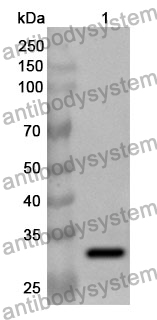Catalog No.
PHG42401
Species reactivity
Human, Mouse, Rat
Host species
Rabbit
Isotype
IgG
Clonality
Polyclonal
Immunogen
E. coli - derived recombinant Human PAK1 (Glu252-Cys501).
Tested applications
ELISA: 1:4000-1:8000, IHC: 1:50-1:100, WB: 1:1000-1:4000
Target
Alpha-PAK,p65-PAK,PAK-1,Serine/threonine-protein kinase PAK 1,p21-activated kinase 1,PAK1
Purification
Purified by antigen affinity column.
Accession
Q13153
Applications
ELISA, IHC, WB
Form
Liquid
Storage buffer
0.01M PBS, pH 7.4, 50% Glycerol, 0.05% Proclin 300.
Stability and Storage
Use a manual defrost freezer and avoid repeated freeze thaw cycles. Store at 2 to 8°C for frequent use. Store at -20 to -80°C for twelve months from the date of receipt.
Increased Fascin1 and Pak1 Expressions Enhance Age-Associated B-Cell Actin Cytoskeleton Remodeling and Motility., PMID:40500987
JEV NS1' protein enhances cell-to-cell viral spread by inducing the formation of tunneling nanotubes., PMID:40187292
Beta cell-specific PAK1 enrichment ameliorates diet-induced glucose intolerance in mice by promoting insulin biogenesis and minimising beta cell apoptosis., PMID:39404845
DCC, a potential target for controlling fear memory extinction and hippocampal LTP in male mice receiving single prolonged stress., PMID:39224830
Novel mechanisms of Anshen Dingzhi prescription against PTSD: Inhibiting DCC to modulate synaptic function and inflammatory responses., PMID:38848974
The Vitamin K-Dependent Anticoagulant Factor, Protein S, Regulates Vascular Permeability., PMID:38666935
Myeloid-derived grancalcin instigates obesity-induced insulin resistance and metabolic inflammation in male mice., PMID:38167327
A personalized network framework reveals predictive axis of anti-TNF response across diseases., PMID:38118442
PAK1 overexpression promotes myxofibrosarcoma angiogenesis through STAT5B-mediated CSF2 transactivation: clinical and therapeutic relevance of amplification and nuclear entry., PMID:37564209
Emerging roles of Aurora-A kinase in cancer therapy resistance., PMID:37521867
The multikinase inhibitor axitinib in the treatment of advanced hepatocellular carcinoma: the current clinical applications and the molecular mechanisms., PMID:37325670
Peritoneal autoantibody profiling identifies p53 as an autoantibody target in endometriosis., PMID:36828054
Inhibition effect of PPAR-γ signaling on mast cell-mediated allergic inflammation through down-regulation of PAK1/ NF-κB activation., PMID:35636075
Siglec-8 Signals Through a Non-Canonical Pathway to Cause Human Eosinophil Death In Vitro., PMID:34721399
Histomorphological patterns of regional lymph nodes in COVID-19 lungs., PMID:33950285
PAK1-Dependent Antitumor Effect of AAC-11‒Derived Peptides on Sézary Syndrome Malignant CD4+ T Lymphocytes., PMID:33745910
[Histomorphological patterns of regional lymph nodes in COVID-19 lungs]., PMID:33575887
Heregulin-induced cell migration is prevented by trastuzumab and trastuzumab-emtansine in HER2+ breast cancer., PMID:33474679
The Essential Role of Peptidylarginine Deiminases 2 for Cytokines Secretion, Apoptosis, and Cell Adhesion in Macrophage., PMID:32785008
Polymeric Vector-Mediated Targeted Delivery of Anti-PAK1 siRNA to Macrophages for Efficient Atherosclerosis Treatment., PMID:33438411
GLCCI1 is a novel protector against glucocorticoid-induced apoptosis in T cells., PMID:30860871
Influence of sphingosine-1-phosphate signaling on HCMV replication in human embryonal lung fibroblasts., PMID:29700602
PAK4 suppresses PDZ-RhoGEF activity to drive invadopodia maturation in melanoma cells., PMID:27765920
Threonine 209 phosphorylation on RUNX3 by Pak1 is a molecular switch for its dualistic functions., PMID:26898755
Overexpression of PAK-1 is an independent predictor of disease recurrence in colorectal carcinoma., PMID:26884861
Neuronal filopodium formation induced by the membrane glycoprotein M6a (Gpm6a) is facilitated by coronin-1a, Rac1, and p21-activated kinase 1 (Pak1)., PMID:26809475
Protein Inhibitor of Activated STAT3 Regulates Migration, Invasion, and Activation of Fibroblast-like Synoviocytes in Rheumatoid Arthritis., PMID:26667168
Kinase-independent role for CRAF-driving tumour radioresistance via CHK2., PMID:26333361
p21-activated kinase 1 determines stem-like phenotype and sunitinib resistance via NF-κB/IL-6 activation in renal cell carcinoma., PMID:25675297
Phosphorylation of tyrosine 285 of PAK1 facilitates βPIX/GIT1 binding and adhesion turnover., PMID:25466889
MicroRNA-145 targets MUC13 and suppresses growth and invasion of pancreatic cancer., PMID:25277192
BRAF activates and physically interacts with PAK to regulate cell motility., PMID:25228413
PAK1 mediates pancreatic cancer cell migration and resistance to MET inhibition., PMID:25074413
Uptake of advanced glycation end products by proximal tubule epithelial cells via macropinocytosis., PMID:23747564
Rac1 selective activation improves retina ganglion cell survival and regeneration., PMID:23734197
Interaction of p190RhoGAP with C-terminal domain of p120-catenin modulates endothelial cytoskeleton and permeability., PMID:23653363
P21-activated kinase 1 (PAK1) as a therapeutic target in BRAF wild-type melanoma., PMID:23535073
Phosphorylation of histone H3 on Ser10 by auto-phosphorylated PAK1 is not essential for chromatin condensation and meiotic progression in porcine oocytes., PMID:23521812
Klotho endows hepatoma cells with resistance to anoikis via VEGFR2/PAK1 activation in hepatocellular carcinoma., PMID:23516476
Regulation of tamoxifen sensitivity by a PAK1-EBP1 signalling pathway in breast cancer., PMID:23361053
The neural cell adhesion molecule (NCAM) associates with and signals through p21-activated kinase 1 (Pak1)., PMID:23303955
Inhibition of Leydig tumor growth by farnesoid X receptor activation: the in vitro and in vivo basis for a novel therapeutic strategy., PMID:23124354
Phosphorylation of β-catenin at serine 663 regulates its transcriptional activity., PMID:22369945
Heparin/heparan sulfate/CD44-v3 enhances cell migration in term placenta-derived immortalized human trophoblast cells., PMID:22321833
Laminin-α1 LG4-5 domain binding to dystroglycan mediates muscle cell survival, growth, and the AP-1 and NF-κB transcription factors but also has adverse effects., PMID:22159078
MUC13 mucin augments pancreatic tumorigenesis., PMID:22027689
Contra-regulation of calcium- and integrin-binding protein 1-induced cell migration on fibronectin by PAK1 and MAP kinase signaling., PMID:21748785
Glia maturation factor-γ mediates neutrophil chemotaxis., PMID:21653232
Activation of a PAK-MEK signalling pathway in malaria parasite-infected erythrocytes., PMID:21371233
Arf nucleotide binding site opener [ARNO] promotes sequential activation of Arf6, Cdc42 and Rac1 and insulin secretion in INS 832/13 β-cells and rat islets., PMID:21276423

